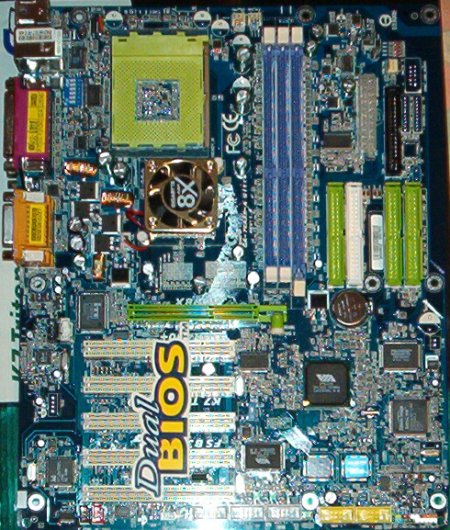|
Spec
| Gigabyte GA-7VAXP-A Ultra | |
| |
Northbridge |
VIA VT8377A KT400A |
| Southbridge |
VIA VT8235CE |
| PCI |
5 x 32-bit, 33MHz |
| Audio |
Realtek ALC650 PHY from VT8235CE |
| Ethernet |
Realtek RTL8100BL |
| IDE |
2 ports, 4 devices from VT8235CE, 2 ports, 4 devices from Promise PDC20276 |
| Memory |
3GB DDR400, 3 slots |
| USB2.0 |
2 backplate, 4 flyoff |
| Firewire |
3 channel from VIA VT6306 |
| Serial ATA |
2 channels from Silicon Image SIL3112 |
| RAID |
PATA RAID 0, 1 from Promise PDC20276. SATA RAID 0, 1 from SIL3112 |
|
Gigabyte do a DFI and put as much as possible on to the board. I think the only thing they missed feature wise was a toaster and that all important kitchen sink. We've got 6 USB2.0, 3 FireWire, 4 channel PATA, 2 with RAID, 2 SATA channels, also with RAID and Realtek audio and Ethernet. Need anything else? Doubt it, unless you have a decent discrete sound card.
If you do, 5 PCI slots should see you right. As far as the PATA and SATA setup you get goes, you have RAID on both options. Obviously, utilising RAID knocks off straight device support. It's about as flexible an ATA setup as you're ever likely to see on a motherboard, bar adding extra controllers. Better than DFI's Marvell bridge too, by a long shot.
I think the only downside is the Silicon Image controller sits on the PCI bus, limiting it to a theoretical 133MB/sec. No SATA150 here, we're bus limited.
|
Shot
Layout
Aieee, I'll learn to use a camera one day. Anyway, despite the poor depiction, we've got enough to discuss the layout. As usual, top to bottom, left to right. No rotated socket here, but it's a nice lurid green to make up for it. Not too many capacitors flanking any edge of the socket this time. 3 blue DDR dimm slots on the right, then some bare board space before we hit the ATX power connector. That's right kids, Gigabyte moved it somewhere nice, it's much better over there than where we've seen it on all previous boards. Just to its right we've got the floppy connector.
We've got VT8235 provided ATA first, then the Promise ports to the right, for some clustered IDE port action underneath the power and floppy ports. That pretty much rounds off the top half of the board, with only a natty heatsink and fan combo on the northbridge. It doesn't need it, passive cooling works for KT400A, but at least it looks good and the fan isn't overly loud, merely mildly annoying on startup before settling down.
Lurid green AGP marks the mid-point of the board vertically. 6 port layout means room under the memory slots, a good thing, as discussed before.
From the mid-point down, all the action on the bottom half of the board is in the right hand corner. It's peripheral city down there, the southbridge takes residence of course, along with the Promise and Silicon Image controllers and all the headers for USB and FireWire bus I/O. Not too cluttered, given what's on it. A decent layout.
BIOS, bundle and manual discussion next, as if you hadn't already guessed.
|










